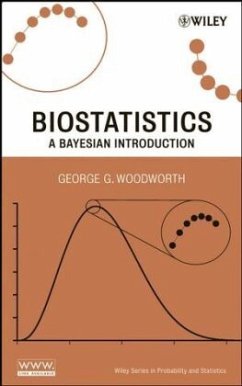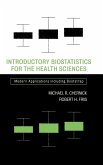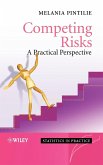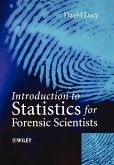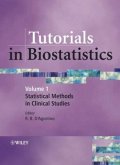Bayesian statistics is a relatively new area. It provides the means by which one interprets statistics from both an observational (or subjective) and a data (or objective) point-of-view. This one-of-a-kind volume is a comprehensive primer that gives individuals the tools to think about the basis of statistical and scientific reasoning within the context of modern Bayesian methods. A recurring theme is teaching readers how to re-interpret conventional statistical reporting (confidence intervals, margins of error, one-sided p-values) in Bayesian terms where possible.
An essential introductory text linking traditional biostatistics with bayesian methods
In recent years, Bayesian methods have seen an explosion of interest, with applications in fields including biochemistry, ecology, medicine, oncology, pharmacology, and public health. As an interpretive system integrating data with observation, the Bayesian approach provides a nuanced yet mathematically rigorous means of conceptualizing biomedical statistics--from diagnostic tests to DNA evidence.
Biostatistics: A Bayesian Introduction offers a pioneering approach by presenting the foundations of biostatistics through the Bayesian lens. Using easily understood, classic Dutch Book thought experiments to derive subjective probability from a simple principle of rationality, the book connects statistical science with scientific reasoning. The author shows how to compute, interpret, and report Bayesian statistical analyses in practice, and illustrates how to reinterpret traditional statisticalreporting--such as confidence intervals, margins of error, and one-sided p-values--in Bayesian terms. Topics covered include:
_ Probability and subjective probability
_ Distributions and descriptive statistics
_ Continuous probability distributions
_ Comparing rates and means
_ Linear models and statistical adjustment
_ Logistic regression and adjusted odds ratios
_ Survival analysis
_ Hierarchical models and meta-analysis
_ Decision theory and sample size determination
The book includes extensive problem sets and references in each chapter, as well as complete instructions on computer analysis with the versatile SAS and WinBUGS software packages as well as the Excel spreadsheet program. For professionals and students, Biostatistics: A Bayesian Introduction offers an unique, real-world entry point into a remarkable alternative method of interpreting statistical data.
Hinweis: Dieser Artikel kann nur an eine deutsche Lieferadresse ausgeliefert werden.
An essential introductory text linking traditional biostatistics with bayesian methods
In recent years, Bayesian methods have seen an explosion of interest, with applications in fields including biochemistry, ecology, medicine, oncology, pharmacology, and public health. As an interpretive system integrating data with observation, the Bayesian approach provides a nuanced yet mathematically rigorous means of conceptualizing biomedical statistics--from diagnostic tests to DNA evidence.
Biostatistics: A Bayesian Introduction offers a pioneering approach by presenting the foundations of biostatistics through the Bayesian lens. Using easily understood, classic Dutch Book thought experiments to derive subjective probability from a simple principle of rationality, the book connects statistical science with scientific reasoning. The author shows how to compute, interpret, and report Bayesian statistical analyses in practice, and illustrates how to reinterpret traditional statisticalreporting--such as confidence intervals, margins of error, and one-sided p-values--in Bayesian terms. Topics covered include:
_ Probability and subjective probability
_ Distributions and descriptive statistics
_ Continuous probability distributions
_ Comparing rates and means
_ Linear models and statistical adjustment
_ Logistic regression and adjusted odds ratios
_ Survival analysis
_ Hierarchical models and meta-analysis
_ Decision theory and sample size determination
The book includes extensive problem sets and references in each chapter, as well as complete instructions on computer analysis with the versatile SAS and WinBUGS software packages as well as the Excel spreadsheet program. For professionals and students, Biostatistics: A Bayesian Introduction offers an unique, real-world entry point into a remarkable alternative method of interpreting statistical data.
Hinweis: Dieser Artikel kann nur an eine deutsche Lieferadresse ausgeliefert werden.
"This book should be very useful in the classroom and for interpretation of the literature, and it is thus highly recommended for students, instructors, and investigators." ( The Annals of Pharmcotherapy , July/August 2005)
"...a very interesting, well written and...very enjoyable and easy to read book...I highly recommend Biostatistics: A Bayesian Introduction ..." ( Statistical Methods in Medical Research , Vol. 14, 2005)
"...suitable for serious students, faculty and researchers, and college libraries supporting biology and biostatistics graduate programs." ( CHOICE , March 2005)
"...a very interesting, well written and...very enjoyable and easy to read book...I highly recommend Biostatistics: A Bayesian Introduction ..." ( Statistical Methods in Medical Research , Vol. 14, 2005)
"...suitable for serious students, faculty and researchers, and college libraries supporting biology and biostatistics graduate programs." ( CHOICE , March 2005)

